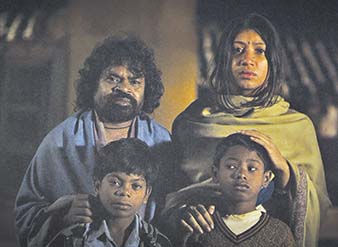A Maze in Chhattisgarh
- Shoma A. Chatterji

- Aug 12
- 3 min read
How a small state’s dialect cinema won India’s highest film honour in 2019.

Chhattisgarh, a heavily forested state in central India, is better known for its temples, waterfalls and tribal markets than for its cinematic output. Sirpur, a temple town on the Mahanadi River near the capital Raipur, boasts the red-brick Lakshmana Temple, adorned with carvings from Hindu mythology. In the far south, Jagdalpur hosts the bustling Sanjay Market on Sundays, a barter hub for local tribes. The thunderous Chitrakoot Falls, further northwest, is the state’s postcard image. Cinema, at least until recently, barely featured in its cultural landscape.
Yet, slowly and stubbornly, a film industry in the local Chhattisgarhi dialect has taken root. These films are aimed squarely at local audiences, and at preserving and projecting Chhattisgarhi culture through simple, often intimate, storytelling.
In 2019, the industry scored an unprecedented breakthrough after ‘Bhulan, The Maze’ became the first Chhattisgarhi film to win a National Award, India’s highest official recognition for cinema.
The film, adapted from Sanjeev Buxy’s novel ‘Bhulan Kanda.’ was directed and produced by Manoj Verma, with his wife Aarti Verma as co-producer. The title refers to a plant found in Chhattisgarh’s forests. Step on it, legend says, and you lose your way, condemned to wander until someone touches you and breaks the spell. Verma uses this folklore as a metaphor for a judicial system that has lost its moral compass, and for the villagers’ own ideas of justice.
Language is central to the film’s authenticity. Villagers speak in Chhattisgarhi; Raipur townsfolk in Hindi; court proceedings in Hindi too, though lawyers lapse into Chhattisgarhi when interrogating rural witnesses.
The story is disarmingly simple. In Mahubhata, a tribal village, two illiterate farmers - Bhakla and Birju - quarrel over land boundaries. One is unaware that the local law has recently changed. In a scuffle, Birju falls on a plough and dies. Bhakla, though innocent, faces the prospect of arrest. Instead, villagers hand over Ganjha, an old, homeless man. His ‘confession’ is motivated by hunger; prison, he reasons, offers food, clothing and shelter.
The plot twists when Ganjha’s good behaviour prompts a kindly jailor to petition the high court for a retrial. The truth emerges that Bhakla was responsible, albeit accidentally. The entire village, however, rallies behind him, arguing he is incapable of malice and must support his wife and children. Their collective deceit leads to mass arrests. Bhakla is sentenced to death. Two different men have now been punished for the same crime. What does that say about the justice system? Has it, too, stepped on the mythical Bhulan Kanda?
Verma’s ending delivers a quiet jolt. The court acquits Bhakla in a rare reversal, underscoring the film’s central question: can a society so wedded to procedural law recognise justice grounded in humanity, solidarity and harmony? “When I read the novel, I found the subject was global,” Verma says. “The metaphor of Bhulan Kanda could portray the actual condition of the social and judicial system anywhere.”
The film’s road to production was, in its own way, a test of local pride. Verma recalls attending the International Film Festival of India (IFFI) in 2011. Introduced to a group of producers as hailing from Chhattisgarh, he was met with incredulity: did the state even have a film industry? One asked, mockingly, whether Chhattisgarhi films ever went beyond the state’s borders.
Verma’s career began in 2009 with Mahun Deewana Tahun Deewani, followed by Mister Tetkuram in 2011 and Du Lafadu in 2012. Bhulan, The Maze proved his most ambitious work, winning awards at various Indian festivals and featuring in non-competitive screenings elsewhere.
Shot across three locations, the film grounds its narrative in the textures of Chhattisgarh. The primary setting is Mahubhata, a Bhunjiya tribal village near Gariyaband, about 130km from Raipur. Prison scenes were filmed at the newly built Khairagarh Jail; courtroom sequences in Raipur. The soundtrack mixes local folk traditions with ghazal poetry by Mir Taqi Mir, set to music by Verma and Praveen Pravaah, and sung by Kailash Kher and others. The cast blends recognisable television faces with non-professional locals, creating the illusion of a documentary.
For all its moral questioning, Bhulan, The Maze is unabashedly mainstream yet its flavour is distinct from Bollywood’s formulaic spectacle. It entertains without diluting its regional essence, proving that small industries can produce cinema that is both culturally specific and nationally resonant.
(The author is a noted film scholar and a double-winner for the National Award for Best Writing on Cinema. Views personal.)





Comments